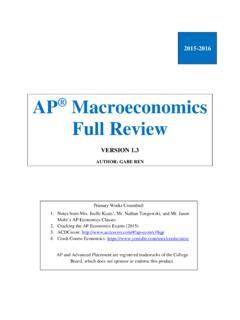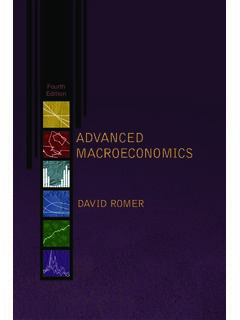Transcription of Intermediate Macroeconomics Practice Problems and ...
1 Intermediate Macroeconomics Practice Problems and solutions Second Edition G. Stolyarov II 1 Intermediate Macroeconomics Practice Problems and solut Ions Second Edition G. Stolyarov II, ASA, ACAS, MAAA, CPCU, ARe, ARC, API, AIS, AIE, AIAF First Edition Published in April-May 2008 Second Edition Published in July 2014 Table of Contents Section Page Section 1: The Economics of Money and Prices 2 Section 2: The Classical Gold Standard 4 Section 3: The Quantity Theory of Money 6 Section 4: Money and Inflation 8 Section 5: The Money Multiplier 10 Section 6: Business Cycles 12 Section 7: The Aggregate Supply / Aggregate Demand Model 14 Section 8: The Federal Reserve 17 Section 9: The Economics of Contemporary Banking 20 Section 10: Monetary Policy and Related Concepts 22 Section 11: Stabilization Policy and the Phillips Curve 25 Section 12: Assorted Questions and solutions on Economic Growth 30 Section 13: Capital, Investment, and Economic Growth 32 Section 14.
2 Exogenous and Endogenous Economic Growth Models 35 About Mr. Stolyarov 39 2008, 2014, G. Stolyarov II. This work is distributed under a Creative Commons Attribution Share-Alike Unported License. Permission to reprint this work, in whole or in part, is granted, as long as full credit is given to the author by identification of the author s name, and no additional rights are claimed by the party reprinting the work, beyond the rights provided by the aforementioned Creative Commons License. In particular, no entity may claim the right to restrict other parties from obtaining copies of this work, or any derivative works created from it. Commercial use of this work is permitted, as long as the user does not claim any manner of exclusive rights arising from such use. While not mandatory, notification to the author of any commercial use or derivative works would be appreciated.
3 Such notification may be sent electronically to Intermediate Macroeconomics Practice Problems and solutions Second Edition G. Stolyarov II 2 Section 1 The Economics of Money and Prices problem 1. Which of these are basic functions of money? More than one answer may be correct. (a) Hedge against price inflation. (b) Unit of account. (c) Tool used for barter. (d) Store of value. (e) Medium of exchange. (f) Automatically appreciating asset. (g) Measure of one's intrinsic human worth. (h) The root of all evil. Solution 1. The three basic functions of money are its usefulness as a medium of exchange, a store of value, and a unit of account. Holding money tends to be a poor decision when there exists dramatic price inflation, and money is designed to avoid, not facilitate, barter. Money does not always appreciate automatically in value, except in times of deflation.
4 Furthermore, money is neither a measure of one's intrinsic human worth nor the root of evil - Paris Hilton and St. Paul notwithstanding. Thus, (b), (d), and (e) are correct answers. problem 2. Which of these are motives for holding money? More than one answer may be correct. (a) Speculative demand (b) Legal tender laws (c) Effective demand (d) Precautionary demand (e) Aggregate demand (f) Transactions demand (g) Exchange demand Solution 2. The three motives for holding money are transactions demand (f) - as many everyday activities and transactions involve spending cash or writing cash - precautionary demand (d) - as money may be needed for unforeseen future contingencies, and speculative demand (a) - resulting from one's uncertainty about the value of money and other assets. Thus, (a), (d), and (f) are correct answers.
5 Intermediate Macroeconomics Practice Problems and solutions Second Edition G. Stolyarov II 3 problem 3. Which of these is a valid formula for L, the demand to hold money? (a) L = MP - where M is the money supply, P is the price level (b) L = P/M - where M is the money supply, P is the price level (c) L = M/P - where M is the money supply, P is the price level (d) L = MV - where M is the money supply, V is the velocity of circulation (e) L = V/M - where M is the money supply, V is the velocity of circulation (f) L = M/V - where M is the money supply, V is the velocity of circulation Solution 3. The correct formula for the demand for money is L = M/P, , answer (c). problem 4. Which of these is true about L(i, Y), the demand to hold money? Here, i is the interest rate, and Y is income. More than one answer may be correct.
6 (a) L/ i < 0, , Li (b) L/ i = 0, , Li = 0 (c) L/ i > 0, , Li > 0 (d) L/ Y < 0, , LY (e) L/ Y = 0, , LY = 0 (f) L/ Y > 0, , LY > 0 Solution 4. If the interest rate i increases, this will reduce the demand to hold money, so LiY > 0. Thus, (a) and (f) are correct answers. problem 5. Which of these are characteristic of a gold standard as historically practiced? More than one answer may be correct. (a) Fluctuating foreign exchange rates. (b) Fixed exchange rates among different currencies. (c) Inflationary central bank tendencies. (d) Free convertibility of currencies into one another. (e) Fixed rates of economic growth. (f) Requirements for occasional explicit cooperation among governments. (g) Strong public distrust in the value of the national currency. (h) The impossibility of running perpetual trade surpluses.
7 Solution 5. A historical gold standard involved fixed gold parity rates in each country - which led to fixed and stable exchange rates among national currencies. So (a) is false and (b) is true. A gold standard kept inflation to a minimum and sometimes was even deflationary; it also gave central banks little discretion, so (c) is false. A gold standard required free convertibility of currencies, so (d) is true. It by no means fixed economic growth (as if anything can!), so (e) is false. The gold standard did require occasional coordination among governments, so (f) is true. Since the gold standard was not inflationary, there was no reason for the public to distrust its value, so (g) is false. David Hume's specie-flow mechanism demonstrated that, under a gold standard, perpetual trade surpluses are impossible, and so mercantilist attempts to run them were self-defeating.
8 Intermediate Macroeconomics Practice Problems and solutions Second Edition G. Stolyarov II 4 Section 2 The Classical Gold Standard problem 6. Which of these is one of the rules entailed in the classical gold standard? (a) Nationalize the gold mines and extract gold at a fixed rate. (b) Set a target rate for growing the money supply. If GDP grows at 3% per year, the central bank should grow the money supply at 3% per year. (c) Fix an official gold price or "mint parity," and convert freely between domestic money and gold at that price. (d) Require banks to hold 100% gold reserves. (e) Prohibit all lending from the central bank to domestic banks. Solution 6. The correct answer is (c): Fix an official gold price or "mint parity," and convert freely between domestic money and gold at that price.
9 problem 7. Which of these is another of the rules entailed in the classical gold standard? (a) Fix all wages and prices in terms of gold. (b) Threaten to retaliate against any nations that deviate from the fixed exchange rate among national currencies. (c) If it is impossible to convert between the national currency and gold as promised, slightly debase the coinage by adding a touch of silver to it. (d) Allow the common price level (nominal anchor) to be endogenously determined by the worldwide demand for, and supply of, gold. (e) Implement a free banking system, abolishing the central bank and removing all banking restrictions and regulations. Solution 7. The correct answer is (d): Allow the common price level (nominal anchor) to be endogenously determined by the worldwide demand for, and supply of, gold.
10 problem 8. Which of these is yet another of the rules entailed in the classical gold standard? (a) Do not restrict exports or imports of gold by private citizens, nor impose any other exchange restriction on current or capital account transacting. (b) Attempt to run a consistent trade surplus in order to accumulate as much gold as possible. (c) Set up tariff barriers on foreign products so as to prevent gold from being redistributed to foreigners. (d) Require a balance of trade among all nations on the gold standard. (e) Require that, while gold-backed notes and goods may exchange hands, the physical gold must not leave a country's borders. Intermediate Macroeconomics Practice Problems and solutions Second Edition G. Stolyarov II 5 Solution 8. The correct answer is (a): Do not restrict exports or imports of gold by private citizens, nor impose any other exchange restriction on current or capital account transacting.






